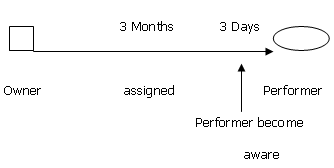January 30th, 2008
TimeMakerTM
TAG DATES
THE PROBLEM:
When an owner assigns a production item to a performer with a target date in the future (let’s say in 3 months from today), the performer may become aware of the task only on or close to the target date and thus may not have enough time to meet the deadline.

Another situation may arise when a task that was not completed will appear in the Owner’s Inbox folder and the owner may want to just move the item out of his Overall Inbox folder for a specific period of time or will want to have the Performer handle the task.
To avoid such a situation, TimeMaker has introduced the Tag concept. Read the rest of this entry »
Posted in New Features | No Comments »
January 30th, 2008
The Tag
The Tag feature allows setting up a reminder for an assigned production task or command, which requires action, and which will appear on the designated date.
A tag, set up in an appropriate way, will warn the performer of an action required for the task or command befor the Target Date. At the same time, the task will not remain open in the user’s Inbox for a protracted period.
Both the owner and the performer can tag an item, indicating that it needs to be completed before the Target Date.
Tagged tasks and commands are added to the Tagged Date Action List.
Introduction to Tag And Nuke
There are three ways of item tagging:
1. Tagging an item by an owner while creating a new item.
2. Tagging an item by a performer while reading the item in the Assigned To Me Tasks folder.
3. Tagging an item by a performer from the Overall Inbox folder (the item has not been opened or viewed).
Read the rest of this entry »
Posted in How to | No Comments »
January 29th, 2008
If you are an executive you need the following - it will save you, truly, from the constant stream of emails and free your time for revenue generating activities… You will see in a moment you NEED and WANT this unique feature from TimeMaker.Let’s see… You remember the days before emails and electronic communication…?
How the system worked?
All mail would arrive to the executive’s secretary who would open the mail. The secretary would handle the mail in one of the following ways:
1. Discard the mail.
2. Route the mail to the executive as personal mail.
3. Route the mail as business related mail for the executive handling.
4. Route the mail to the executive with a suggested reply.
5. Handle the mail and may or may not inform the executive as to the handling.
Back then, the executive did not get junk mail and could train his secretary to assist him with an increasing number of issues.
With the introduction of email the executive became the one who often has to handle all the communication as it arrives directly to his PC. Even elaborate systems involving special email addresses between executives and their assistants usually cannot give the assistant the degree of control necessary to completely manage the executive’s email.
Read the rest of this entry »
Posted in New Features, Management | No Comments »
January 17th, 2008
List of new features in 1.0.478
Posted in Development, New Features | No Comments »
January 8th, 2008
List of new features in 1.0.470
Posted in Development, New Features | No Comments »
December 12th, 2007
List of new features in 1.0.454
Posted in Development, New Features | No Comments »
November 23rd, 2007
List of new features in 1.0.440
Posted in Development | No Comments »
October 15th, 2007
List of new features in 1.0.410
Posted in Development | No Comments »
October 15th, 2007
Until now we have been using a default code page for English e-mail: ISO8859_1. This is the name which is widely used by Java. However, because some older versions of MS Exchange server have a problem with this designation, we are now using iso-8859-1, which is the MS Windows name for the same code page.
Posted in Development, Technical | No Comments »
September 28th, 2007
List of new features in 1.0.395
Posted in Development | No Comments »
